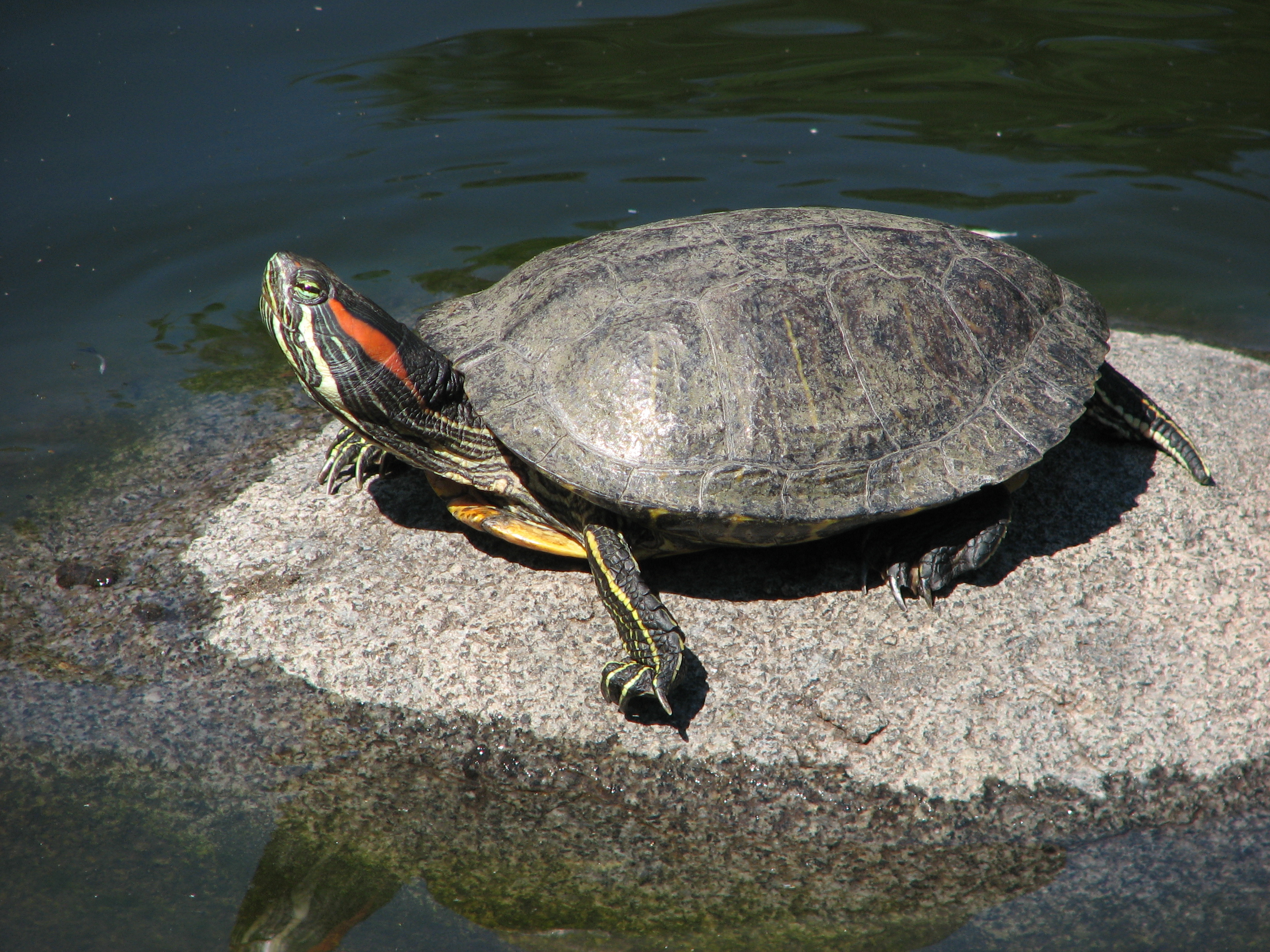Red-Eared Slider Turtle
Trachemys scripta elegans

Vectors of spread:
ID Characteristics
Size: Adults can reach 29 cm in length, while hatchlings are around 2-3.5 cm long.
Colour: Hatchlings are green, with yellow and darker green markings on the head, legs, neck, and carapace (upper shell). Adults are distinguishable from other turtle species by the red “ear” patch behind the eye. Yellow stripes decorate the face and the neck, while the carapace is decorated with dark lines and swirls. The plastron (lower shell) of adult individuals is yellow with dark blotches.
Life Cycle: Individuals have a lifespan of 20-40 years, and reach sexual maturity between 3-4 years.
Similar Species
- Western Painted Turtle (Chrysemys picta bellii): Lacks the red “ear” patch that the Red-Eared Slider Turtle has behind the eye. Red-Eared Sliders compete with Western Painted Turtles for nesting sites, basking sites, and food.

Habitat and Origin
Red-Eared Sliders are native to the southeastern United States, Mexico, Central America and Brazil. They are an introduced species to Europe, Asia, and many other regions in North America, including the southern regions of British Columbia, Ontario, and Quebec. The global presence of Red-Eared Sliders can be attributed to both the pet trade and the commercial food trade in Asia.
This species prefers to make its home in freshwater ecosystems with slow currents and muddy bottoms, such as streams, rivers, swamps, ponds, and lakes. Hibernation occurs in mud or logs during the winter, while feeding and basking occur on rocks and logs in the summer.
Reproduction
Female Red-Eared Sliders lay 2-23 eggs in a cavity dug out of the soil during April or May, and can lay up to 5 clutches each year! Hatchlings typically emerge from the nest around June or July, but they may even emerge the following spring if temperatures are too low.
Current Distribution

Source: https://www.bcreptiles.ca/turtles/redearslider.htm
Vectors of Spread
Red-Eared Slider Turtles are popular pets as hatchlings and juveniles. However, when they reach their full and often unexpected size, housing and care become difficult and pet owners discover that it is harder to care for a Red-Eared Slider than they might have originally thought. Pet owners often decide to release their unwanted Red-Eared Sliders into the nearest water body once they deem care too difficult.
The popularity of this turtle as a pet can be traced back to the cartoon Teenage Mutant Ninja Turtles, of which the main characters are Red-Eared Sliders.
Red-Eared Slider Turtles have been known to escape during transport, as well as from aquaculture farms that supply the commercial food trade in Asia. Once Red-Eared Sliders have been introduced to an area, females may disperse up to 2 km to lay eggs.
Report
Please report any sighting of Red-Eared Slider Turtle by clicking here.
Ecological and Health Impacts
Ecological:
- Red-Eared Sliders compete with native turtle species, such as the Western Painted Turtle, for nesting sites, basking sites, and food. An abundance of nesting and basking sites for native turtle species is important to keep their populations stable.
- In addition, Red-Eared Sliders disrupt the delicate food webs of aquatic ecosystems and may contribute to the accelerated population decline in native amphibian species.
- This species is highly adaptive and can survive in a range of water bodies and conditions. Sightings of the Red-Eared Slider Turtle have even been reported in polluted waters.
Health:
- Red-Eared Sliders are a source of human salmonellosis and can spread this to humans through contact with shed skin.
What Can I Do?
Red-Eared Slider Turtles have been spotted throughout the Lower Mainland, but their presence has only been reported in a few locations in the Sea to Sky Region, so PREVENTION of further spread is key.
Learn to identify Red-Eared Slider Turtles: use the images presented in this profile page.
What to do if you spot it: You can report any Red-Eared Slider Turtle sighting by clicking here.
Don’t Let It Loose. Through public education and awareness, encourage pet owners to consider re-homing services and rescue centers for unwanted Red-Eared Sliders or euthanasia as a last resort. Re-homing services in the Sea to Sky include:
Ensure information about proper care available. Pet shops or retailers should provide proper care sheets for Red-Eared Sliders, and ensure that any potential pet owners know the size and lifespan of the species.
Do not:
- Release a Red-Eared Slider Turtle into the wild.
- Capture a Red-Eared Slider and release it into an area where they do not occur, like Whistler or Pemberton.
References
- BC Reptiles, Red-eared Slider, https://www.bcreptiles.ca/turtles/redearslider.htm
- Canadian Wildlife Federation (CWF), Red Eared Slider, http://cwf-fcf.org/en/resources/encyclopedias/fauna/amphibians-and-reptiles/turtles/red-eared-slider.html
- E-Fauna BC, Trachemys scripta, https://linnet.geog.ubc.ca/efauna/Atlas/Atlas.aspx?sciname=Trachemys%20scripta&ilifeform=43
- Global Invasive Species Database (GISD), Trachemys scripta elegans, http://www.iucngisd.org/gisd/species.php?sc=71
- Invasive Species Compendium, Trachemys scripta elegans (red-eared slider), https://www.cabidigitallibrary.org/doi/10.1079/cabicompendium.61560
- Ontario Nature, Don’t Set Them Free!, https://ontarionature.org/dont-set-them-free/
- US Geological Survey (USGS), Red-Eared Slider Turtle, https://nas.er.usgs.gov/queries/FactSheet.aspx?SpeciesID=1261








